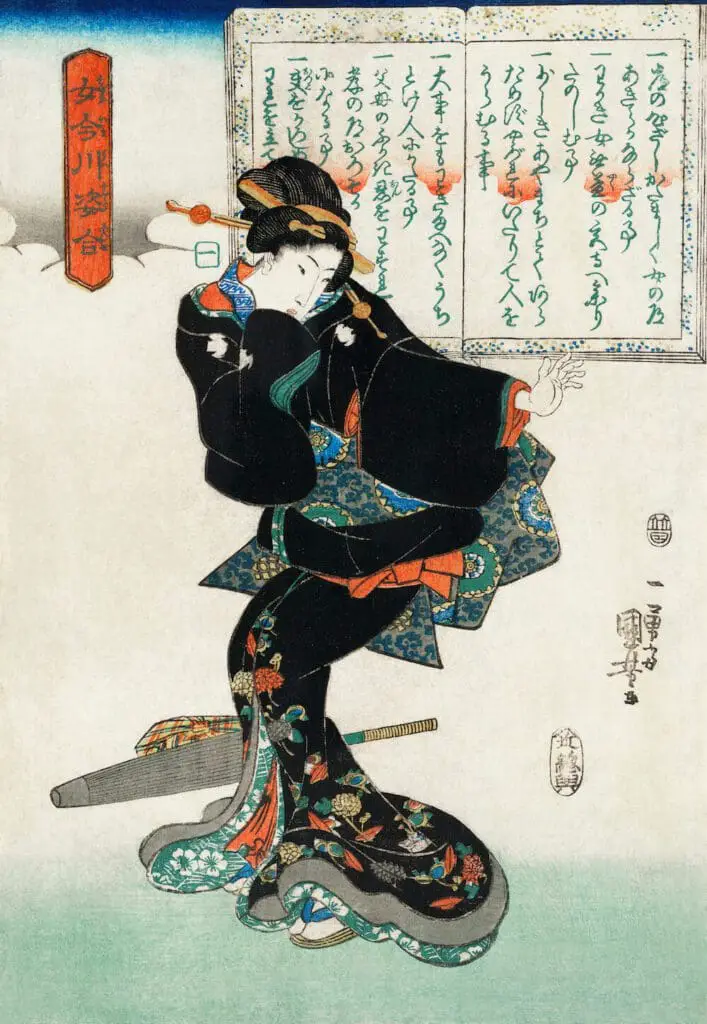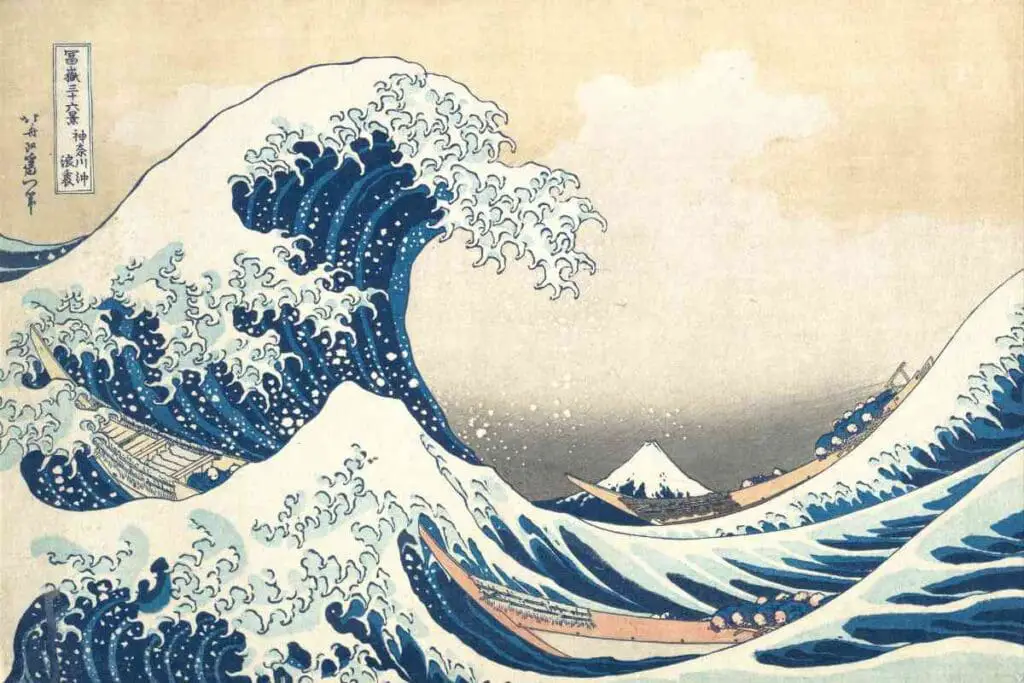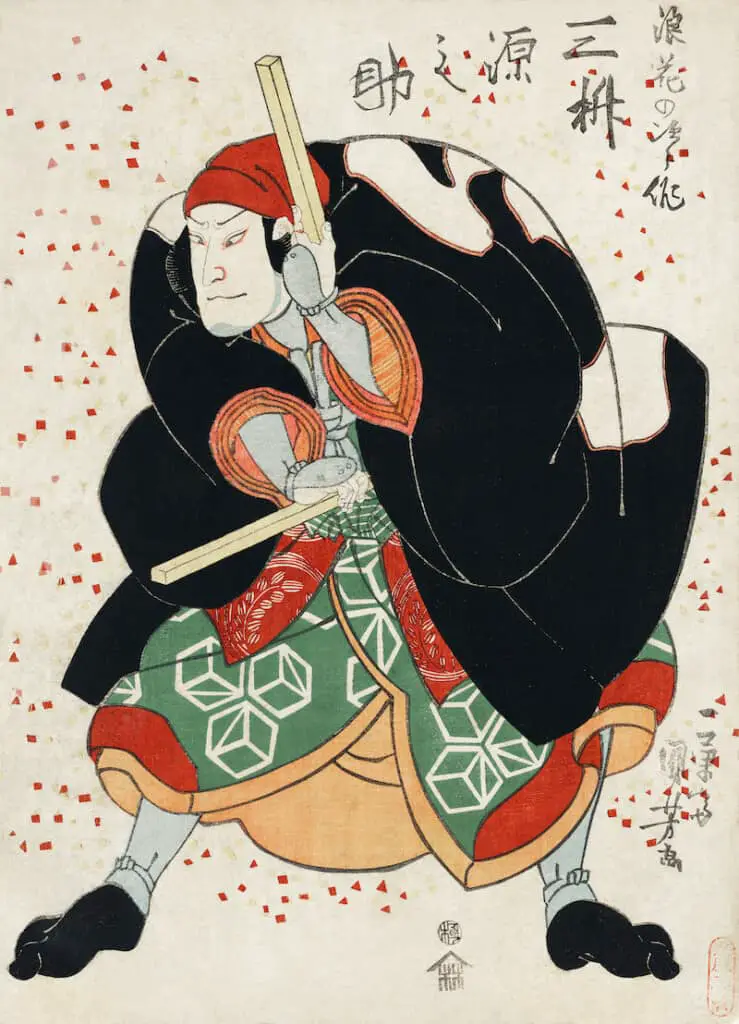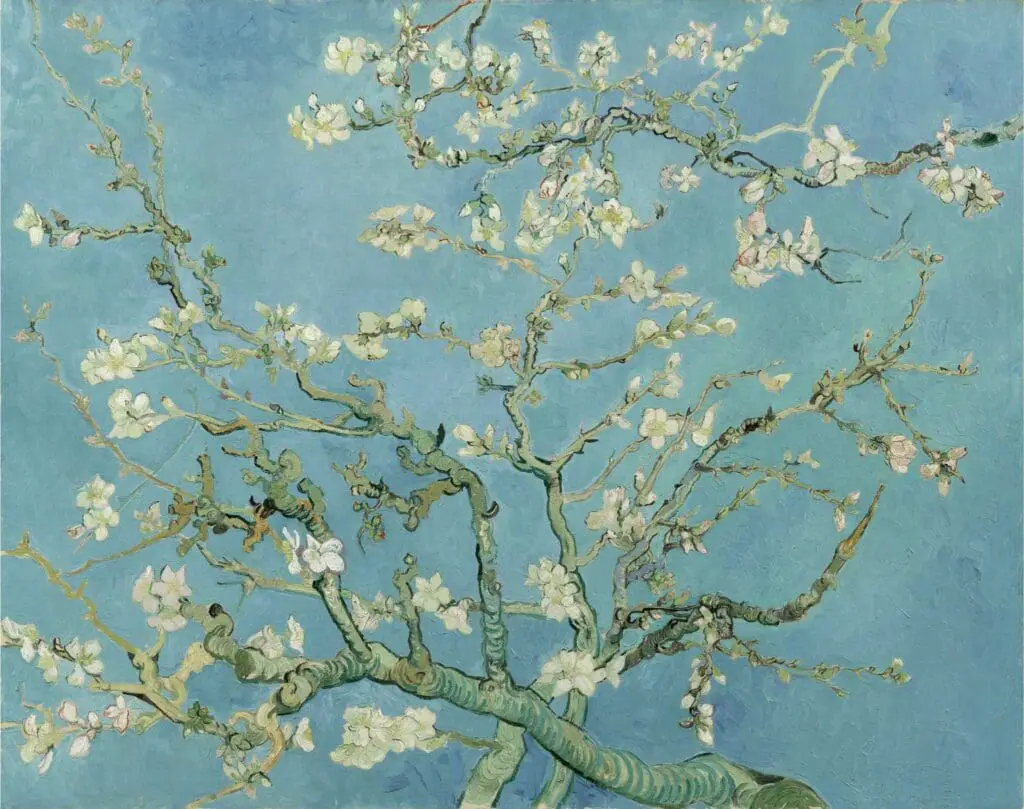I am fascinated by Japanese Woodblock prints. It is amazing how the Japanese woodblock artists execute their art using this woodblock technique.
A Japanese woodblock print is, as the name implies, a print that is made by using carved woodblock and applying ink on the woodblocks to print a design on paper. The Japanese woodblock artists used woodblocks to print artistic prints and even books. Artists have used the woodblock print technique in Japan for hundreds of years.
Table of Contents
- Japanese Woodblock Prints Defined
- Japanese Woodblock Prints History
- Significant Art Periods of Japanese Woodblock Prints
- Japanese Woodblock Prints Influence On Western Artists
- Frequently Asked Questions
- Related Questions

Japanese Woodblock Prints Defined
Japanese woodblock prints are made by carving a design on a block or series of wood blocks. The carved wood is then used to print the design onto paper.
As the woodblock is carved, Japanese artists can print multiple prints or books using the woodblock printing system. This is why, even today, you can find multiple print copies of the same Japanese woodblock print design.

Basic Process To Create Japanese Woodblock Prints
Japanese woodblock prints were created using a consistent, traditional process. Here’s an overview of how these iconic prints were produced:
Drawing of The Designs –
First, the artist drew their design on a thin Japanese paper called “washi.” The design drawn on the paper would act as a pattern for the actual carving of the woodblock.
Paper Glued on Woodblock –
The thin, fragile “washi” paper is then glued onto the woodblock. The paper would be glued facedown as everything needed to be carved in a mirror image.
The kind of wood used needed to be soft enough to carve and hard enough to keep the detail through the printing process; cherry wood was the wood of choice.
Oil Place on Paper –
Many times, oil would be placed on the thin “washi” paper to help make the lines of the paper’s image more visible.
Wood Carving –
The artist would then carve the design onto the woodblock, using the paper’s design as a guide.
Ink placed on the block –
Once the carving is completed, the artist can place the ink on the woodblock to print the design. The artist used a unique tool to rub the paper against the woodblock to make the print.
For a one-color print, the artists only needed one carved woodblock. But they would need several carved woodblocks for additional colors for one print. The Japanese artists could layer the woodblock prints with multiple colors with great precision.
The ink used in the Japanese traditional woodblock prints was transparent enough to ensure that each layer would build upon the previous layer. That is one of the amazing techniques used with Japanese woodblock printing.
Japanese woodblock artists became very sophisticated in how they were able to use color layers. When you see many of these woodblock prints, you can see how sophisticated these Japanese artists used multiple colors in their designs.
This short video from the Utah Museum of Fine Art shows the woodblock process, from carving the woodblock to printing the prints. Wood blocks are used for each color; each color must be aligned for the desired design and effect. This kind of carving and woodblock printing takes tremendous skill.
Japanese Woodblock Prints History
The Japanese woodblock printing dates back to the eighth century. It was initially used to reproduce Buddhist text and scripture. It wasn’t until the early 1500s that books were printed with illustrations using woodblock prints.
These books helped pave the way for the standalone woodblock images that many are familiar with today.

Significant Art Periods of Japanese Woodblock Prints
In the rich tapestry of Japanese art, woodblock prints stand out for their distinctive style and historical significance. Spanning various significant art periods, these prints reflect Japan’s evolving cultural and artistic landscape.
Read on as we delve into the pivotal eras that shaped this unique art form, from the classical Ukiyo-e period to modern interpretations. Here, we’ll explore how each period contributed to Japanese woodblock prints’ enduring legacy and aesthetic.
Sumizuri-e – Black and White Prints
The first woodblock printed images were black-and-white prints known as the Sumizuri-e era of woodblock prints. The artist’s drawing would be transferred from paper to a cherry wood block; the woodblock was carved and each from blank sheets of paper or laid on top of the woodblock for printing.
One of the great masters of this era was considered Hishikawa Moronobu (1618-1694).
Nishiki-e Woodblock Prints – The Begining of Color Prints
Printing more than one color on the prints using the woodblocks required a lot of skill. The Japanese Artist Suzuki Harunobu (1724 -1770) caused a huge breakthrough in woodblock printing as he began to master an array of colors in his woodblock prints.
Suzuki used a set of woodblocks and defined each of the woodblocks. This is how he explained each of them:
- Key block – Suzuki started with what is called a key block. This was the design’s outline that was carved into the relief. The key lock was printed and then used to make additional woodblocks.
- Color blocks – Each color block was carved according to the color that would be used. Each block would need to be carefully aligned. Also, a registration system helped ensure careful alignment between each color block.
The idea to carve first the key block and then print and use that key block for other blocks helped ensure that each print color would then be aligned correctly.

Ukiyo-e – Major Japanese Woodblock Print Era
The Ukiyo-e, the woodblock prints era, is considered the major era of woodblock prints. The subjects of the artists used are divided into three major subject categories:

Courtesan and Kabuki Actors Ukiyo-e Woodblock Prints
The name Ukiyo-e means “pictures of the floating world;” the name was about transient pleasures offered in the Edo (present-day Toyko) district of Yoshiwara.
To show their loyalty to the Shogun, the feudal lord was required to spend one month in Ido or present-day Tokyo each year; they would leave their families in other parts of Japan. They will arrive in Tokyo with Samara and others, creating a large Edo community (Tokyo).
To ensure this large group was thoroughly entertained, the Yoshiwara district of pleasure (red-light district) sprung up. Restaurants, tea houses, and brothels became a popular form of entertainment. Many courtesans and kabuki actors became the celebrities of this era.
The Japanese woodblock artists also caught on to this new market and started to do woodblock prints of these early Japanese celebrities. In fact, many of these woodblock prints became so prominent that a woodblock print of your favorite celebrity would cost you the same as a bowl of noodle soup.

Landscape Ukiyo-e Woodblock Prints
In the early 19th century, many Ukiyo-e woodblock artists started to shift their focus from the celebrity culture to landscapes. This was because there was an increase in travel made possible by five major new highways that connected Edo (Tokyo) with the rest of Japan.
Two of the most incredible landscape artists during this period were Hiroshige and Hokusai. Both of them focused on the woodblock landscapes from different viewpoints and different seasons of the year.
One of the most famous woodblock print series is Hokusai’s “Thirty-six Views of Mount Fiji. The most notable from this series is The Great Wave. The Great Wave is so popular that even today, there are emojis inspired by The Great Wave.
You can learn more about the Great Wave by reading our blog The Great Wave Off Kanagawa by Japanese Artist Hokusai (1790-1849) by clicking here.

Warriors and Japanese Heroes Ukiyo-e Woodblock prints
Another big subject matter for 19th-century Japanese woodblock artists was warriors and Japanese heroes. One of the major artists of this genre and period was Utagawa Kuniyoshi (1798-1861). Utagawa Kuniyoshi brought together the warriors’ and Japanese heroes’ drama, dynamics, and imagination to the woodblock medium. His woodblock prints proved to be hugely popular.
If you’d like to learn more about him and his life, you can read our blog Who Is the Japanese Woodblock Print Artist Utagawa Kuniyoshi (1798 – 1861)? by clicking here.

Japanese Woodblock Prints Influence On Western Artists
Before 1868, Japan was cut off from the rest of the world; this was a great isolation period. Japan had stopped all trade with all other nations and banned travel in and out of Japan.
In 1868, when the final shogun, Takagawa, was ousted, this isolationist situation changed. Japan began to open its borders for trade. As part of this trade, the Ukiyo-e woodblock prints were exported to the Western world.
One example of how these woodblock prints affected Western artists was Van Gogh. Van Gogh started to use brighter colors in his artwork and enhance contrasts.

The Japanese Ukiyo-e prints influence is evident in Van Gogh’s later work, where the Japanese culture and traditions strongly influenced Van Gogh’s art. The use of black contours is also an element typical of Japanese woodblock prints that many European artists started to use in their art.
The Japanese woodblock prints are the kind of art that seems in many ways to be timeless. The art is still as relevant today as it was many years ago when these Japanese artists produced these woodblock prints.
Anita Louise Art is dedicated to art education, great artists, and inspiring others to find and create their art. We love art that uplifts and inspires. #ArtToMakeYouSmile! #ArtToMakeYouHappy!
If you want to see any of my art, you can find out more by clicking here. If you are interested in what inspires me and my paintings, you can discover more by clicking here.
We have a free newsletter and would love you to be part of our community; you can subscribe to the newsletter by clicking here. If you have any questions, I would be happy to talk to you anytime. You can reach me, Anita, by clicking here.
Subscribe to our Anita Louise Art YouTube Channel with great videos and information by clicking here.
Join us for our podcast “5 Minutes With Art.” just 5 minutes a week with us to discover and learn about great art and artists. You can find out more about our podcast by clicking here.
Frequently Asked Questions
What is a Japanese Woodblock Print?
A Japanese Woodblock Print is a traditional art form where artists carve intricate designs into wooden blocks, apply ink to the blocks, and then transfer the design onto paper. This technique has been employed for centuries in Japan to create beautiful prints and books.
How is the Japanese Woodblock Printing Process Executed?
The process involves several steps. First, an artist carves a design into a wooden block. Ink is then applied to the carved surface, and paper is pressed onto the block to transfer the design. Multiple blocks are often used for different colors in a single print.
What Materials are Used in Japanese Woodblock Printing?
Traditional Japanese Woodblock Printing involves the use of wood for carving the blocks, water-based inks, and handmade paper. Various types of wood, such as cherry or pine, may be used depending on the artist’s preferences.
Can You Explain the Historical Significance of Japanese Woodblock Prints?
Japanese Woodblock Printing has a rich history dating back centuries. It gained popularity during the Edo period (1603-1868) and was widely used for creating ukiyo-e prints depicting landscapes, kabuki actors, and beautiful women, among other subjects.
How Were Japanese Woodblock Prints Used in Art and Literature?
Aside from standalone art prints, woodblock printing was utilized in creating illustrated books and novels. This allowed for the mass production of literature and art, making it more accessible to a broader audience during historical periods.
Who Were Some Notable Artists in Japanese Woodblock Printing?
Renowned artists like Katsushika Hokusai and Utagawa Hiroshige are among the pioneers of Japanese Woodblock Printing. Their works, such as Hokusai’s “The Great Wave off Kanagawa,” have become iconic representations of the art form.
How Did Japanese Woodblock Printing Influence Western Art?
Japanese Woodblock Printing had a profound impact on Western artists during the late 19th century, particularly the Impressionists. The bold compositions, vibrant colors, and flattened perspectives of ukiyo-e prints inspired Western artists like Vincent van Gogh and Claude Monet.
Is Japanese Woodblock Printing Still Practiced Today?
Yes, Japanese Woodblock Printing continues to be practiced by contemporary artists. While traditional techniques are preserved, some artists also incorporate modern elements, creating a fusion of traditional and contemporary art.
What Themes Are Commonly Explored in Japanese Woodblock Prints?
Traditional Japanese Woodblock Prints often depict nature, landscapes, actors, and scenes from everyday life. Symbolism, seasonal motifs, and cultural references are commonly explored themes in these prints
How Has Technology Impacted Japanese Woodblock Printing?
While traditional methods are still cherished, modern technology has influenced the art form. Artists may use digital tools for design, and new printing techniques have emerged. However, many artists strive to maintain the authenticity and craftsmanship of traditional Japanese Woodblock Printing.
Related Questions
How Do You Identify A Japanese Artist’s Signature on Woodblock Prints?
The signature on a Japanese woodblock print is the Japanese characters above or near the red artistic seal or chop. Sometimes the artist would add words behind their own name, such as “designed by.” Other times, the artist would use different chops or seals during different periods of their life. Many times, the actual artist’s signatures are complicated to read.
You can read more by reading our blog How Do You Identify A Japanese Artist’s Signature on Woodblock Prints? by clicking here.
What Is The Main Difference Between Japanese and Chinese Art?
The main differences between Japanese and Chinese art include the materials used and how they were executed. Religion played a significant role in influencing both Japanese and Chinese art. Both countries were Buddhist, but Japan also had the Shintoism influence, and China had Confucianism and Taoism.
You can learn more by reading our blog What Is The Main Difference Between Japanese and Chinese Art? by clicking here.


